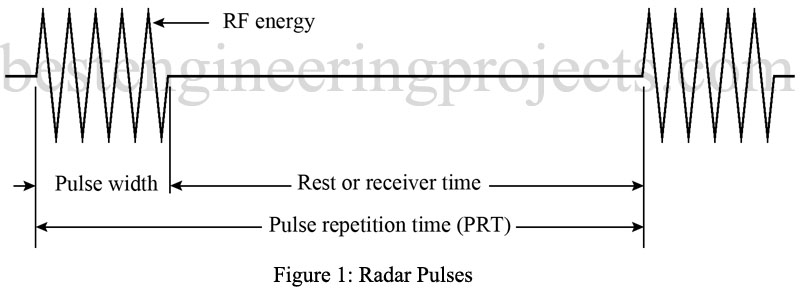Radar Waveform and Range Determination: A representative radar pulse (waveform) is shown in Fig. 1. The number of these pulses transmitted per second is called the pulse repetition frequency (PRF) or pulse repetition rate (PRR). The time from the beginning of one pulse to the beginning of the next pulse is called the pulse repetition time (PRT). The PRT is the reciprocal of the PRF (PRT = 1/PRF).
The duration of the pulse (the time the transmitter is radiating energy) is called the pulse width (PW). The time between pulses is called rest time or receiver time. The pulse width plus the rest time equals the PRT (PW + rest time = PRT). In order for radar to provide an accurate directional picture, a highly directive antenna is necessary. The desired directivity can only be provided by microwave antennas (see Chapter 16), and thus the RF energy shown in Fig. 1 is usually in the GHz (microwave) range.
The distance to the target (range) is determined by the time required for the pulse to travel to the target and return. The velocity of electromagnetic energy is 186,000 statute mi/s, or 162,000 nautical mi/s. (A nautical mile is the accepted unit of distance in radar and is equal to 6076 ft.) However, in many instances, measurement accuracy is secondary to convenience, and as a result a unit known as the radar mile is commonly used. A radar mile is equal to 2000 yd, or 6000 ft. The small difference between a radar mile and a nautical mile introduces an error of about 1% in range determination.
Radar Waveform and Range Determination | Calculation of Range
For purposes of calculating range, the two-way travel of the signal must be taken into account. It can be found that it takes approximately 6.18 us for electromagnetic energy to travel 1 radar mile. Therefore, the time required for a pulse of energy to travel to a target and return is 12.36 us/radar mile. This takes into account the two-way travel time. The range, in miles, to a target may be calculated by the formula
…..(Eq.1)
where is the time between transmission and reception of the signal in microseconds. However, for shorter ranges and greater accuracy, range is measured in meters.
…..(Eq.2)
where c is the speed of light and is in seconds.
